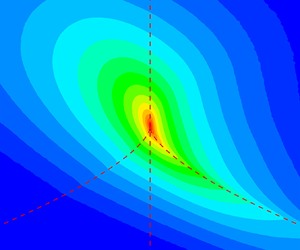Published online by Cambridge University Press: 18 January 2022

A direct numerical simulation database of a weakly compressible turbulent channel flow with bulk Mach number 1.56 is studied in detail, including the geometrical relationships between the pressure-Hessian tensor and the vorticity/strain-rate tensor, as well as the mechanism of the pressure-Hessian tensor contributing to the evolution of invariants of the velocity gradient tensor. The results show that the geometrical relationships between the pressure-Hessian tensor and the vorticity/strain-rate tensor in the central region of the channel are consistent with that of isotropic turbulence. However, in the buffer layer with relatively stronger inhomogeneity and anisotropy, the vorticity tends to be aligned with the first or second eigenvector of the pressure-Hessian tensor in the unstable focus/compressing topological region, and tends to be aligned with the first eigenvector of the pressure-Hessian tensor in the stable focus/stretching topological region. In the unstable node/saddle/saddle and stable node/saddle/saddle topological regions, the vorticity prefers to lie in the plane of the first and second eigenvectors of the pressure-Hessian tensor. The strain-rate and the pressure-Hessian tensors tend to share their second principal direction. Moreover, for the coupling between the pressure-Hessian tensor and the principal strain rates, we clarify the influence on dissipation, the nonlinear generation of dissipation and the enstrophy generation. The decomposition of the pressure-Hessian tensor further shows that the slow pressure-related term dominates the pressure-Hessian tensor's contribution, and the influence of inhomogeneity and anisotropy mainly originates from the inhomogeneity and anisotropy of the fluctuating velocity. These statistical properties would be instructive in formulating dynamical models of the velocity gradient tensor for wall turbulence.